By default, when journaling to a Barracuda Message Archiver from Microsoft Exchange, you must configure the send connector to send mail to one of the two units. If that unit goes down, you must manually change the send connector IP address to point to the other unit. This can potentially result in lost mail. If you have a Barracuda Load Balancer ADC and Barracuda Message Archiver in a High Availability (HA) setup, Barracuda Networks recommends using the steps in this article to configure the Barracuda Load Balancer ADC to handle the SMTP traffic and balance it accordingly.
Step 1. Configure the Barracuda Message Archiver
- Log in to the first Barracuda Message Archiver, and go to the Mail Sources > SMTP page.
- In the Trusted SMTP Servers section, enter the IP of your Exchange Servers as well as the LAN IP of your Barracuda Load Balancer ADC.
- Go to the Basic > IP Configuration page. In the TCP/IP Configuration page, update the Default Gateway to point to the LAN IP address of your Barracuda Load Balancer ADC.
- Click Save.
- Complete steps 1-4 in this section for the second Barracuda Message Archiver in the HA setup.
Step 2. Configure the Barracuda Load Balancer ADC
- Log in to your Barracuda Load Balancer ADC using your admin credential, and go to the BASIC > Services page.
- In the left pane, click Add Service:

- In the name field, type: Barracuda_Message_Archiver_SMTP
- Select default as the Group, and from the Type drop-down menu, select TCP Proxy.
- In the IP Address field, enter an available internal IP address to be used for this service followed by port 25.
- Enter your network Netmask, and select the Interface:
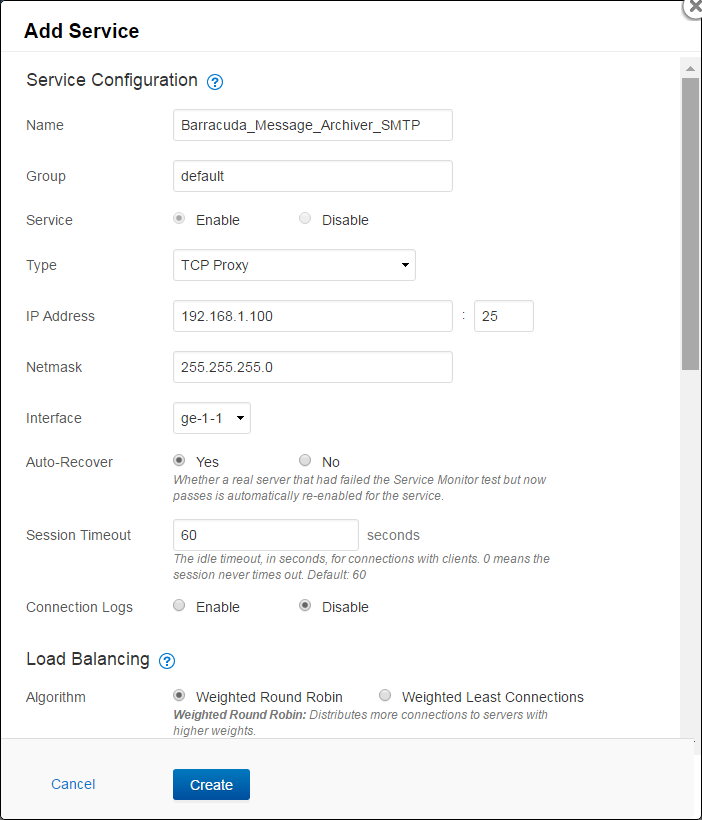
- Click Create.
Step 3. Add the Barracuda Message Archivers to the Service
Once you create the service, add the two Barracuda Message Archivers as the real servers.
- Log in to your Barracuda Load Balancer ADC using your admin credential, and go to the BASIC > Services page.
- Click Add Server:

- For the primary Barracuda Message Archiver, enter the device name in the Name field, and enter the IP Address followed by the Port number (25):
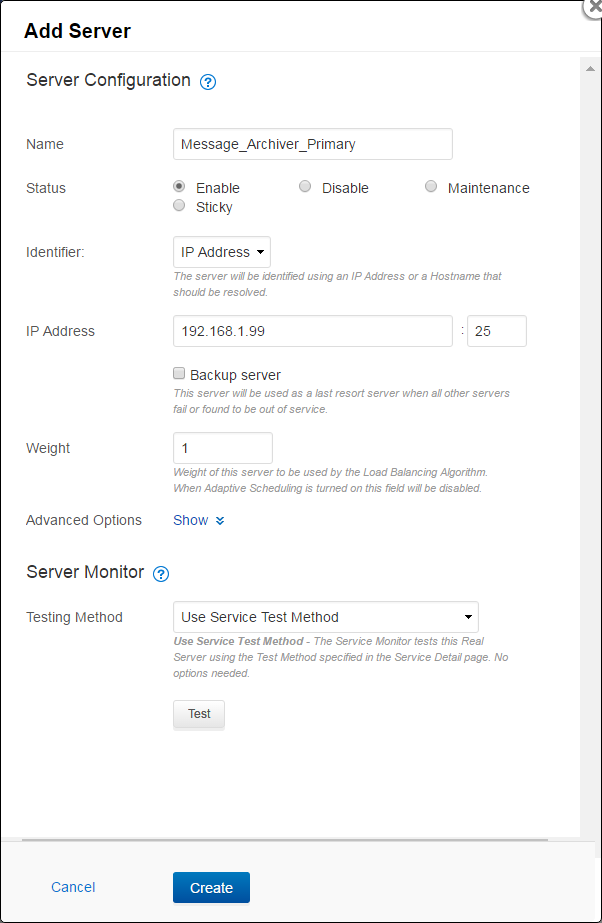
- Click Create.
- Click Add Server:

- For the secondary Barracuda Message Archiver, enter the device name in the Name field, and enter the IP Address followed by the Port number (25).
- Select Backup server:
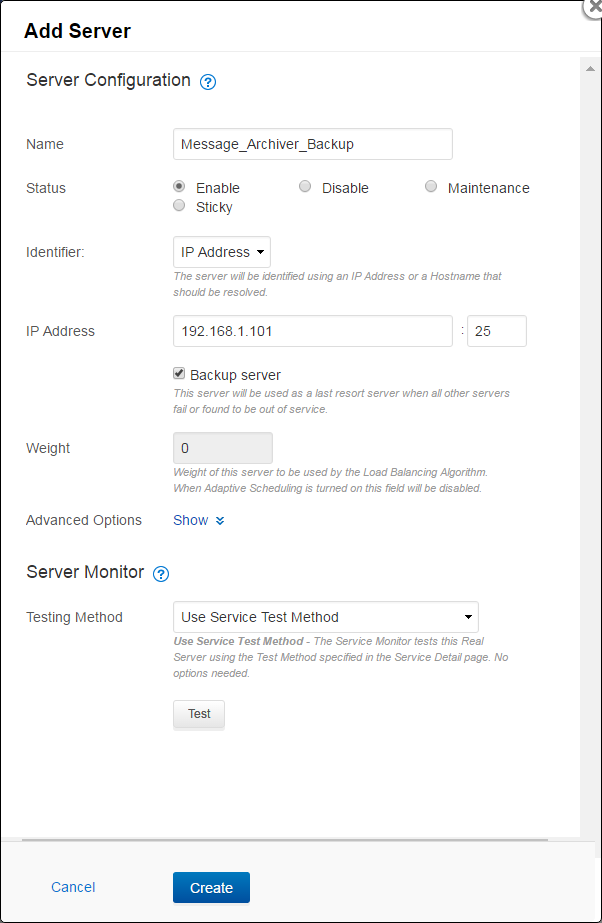
- Click Create.
Both the primary and backup Barracuda Message Archivers should now display in the Configured Servers table with a green checkmark icon in the Status field indicating the real servers are up and responding to requests:

If the Status field does not display the green checkmark icon for one or more configured servers, verify you have entered the correct IP address and are able to reach the device over port 25.
- Click Save Changes.
Step 4. Configure Journaling
Select your journaling deployment.
Configure Envelope Journaling for Microsoft Exchange Server 2013 and Newer - Standard
Microsoft Exchange allows a Journal recipient to be either a mailbox or contact. By using a contact with an email address that is part of a non-existent domain, you can create a send connector that uses SMTP to deliver journaled mail to the Barracuda Message Archiver. Use the steps in this article to configure Envelope Journaling.
Use the examples in this article to simplify troubleshooting. Note that you can cut and paste the shell commands directly from this article.
Step 1. Register Each Exchange Server as a Trusted SMTP Server
To ensure that archiving begins as soon as your Exchange Servers are configured to send journal copies, first register each Exchange Server that is in a Client Access Server (CAS) role as a Trusted SMTP Server with the Barracuda Message Archiver on the MAIL SOURCES > SMTP page in the web interface.
- Log into the Barracuda Message Archiver web interface, and go to the MAIL SOURCES > SMTP page.
- In the Trusted SMTP Servers section, enter the details for each Exchange Server that is to journal directly to the Barracuda Message Archiver; click Add after entering the details for each Exchange Server, and then click Save.
Step 2. Create a Remote Domain From the Exchange Management PowerShell
The Remote Domain must not be your normal email domain. The remote domain must be a non-existent and non-routable/unresolvable domain from either inside or outside your organization (such as bma.int). This domain must be used for the email address of the Mail Contact that is to be the journaled message recipient.
Remote Domain
In previous versions of Exchange Server, the Exchange Management Console was used to create a Remote Domain; in Exchange Server 2013 the ECP/EAC has no analogous functionality so you must use PowerShell to create the Remote Domain.
To create a Remote Domain, you must enter a Name to describe the domain, and the actual Domain Name to use. In this example, bma.int is the "fake" Domain Name that is used. You can use bma.int or create your own "fake" Domain Name. Note that this Domain Name is used when creating the Mail Contact in Step 4. Create a Send Connector for the Remote Domain.
- Open the Exchange Management Shell.
- Execute the following command to create the remote domain; this command ensures TNEF encoding is disabled:
New-RemoteDomain -DomainName bma.int -Name "Message Archiver Domain" - Next, execute the following command to enable auto-forwarding:
Get-RemoteDomain | Where {$_.DomainName -eq "bma.int"} | Set-RemoteDomain -TNEFEnabled $false -AutoForwardEnabled $true - Enter the following command to verify the settings:
Get-RemoteDomain | Where {$_.DomainName -eq "bma.int"} |Format-table Name, DomainName, TNEFEnabled, AutoForwardEnabled
Step 3. Create a Recipient Mail Contact/Alternate Email Address
The Mail Contact is the account that is to act as a "holding location" for journaled messages. The email address associated with this account is the designated recipient and must be associated with a non-existent, non-routable dummy Domain Name created above in Step 2. Create a Remote Domain From the Exchange Management PowerShell. Use the following steps to create the Mail Contact:
- Log in to the Exchange Admin Center (EAC), and click recipients > contacts.
- Click the + symbol, and click Mail contact:

- In the new mail contact dialog box, enter the following details:
- First name – Type Barracuda
- Initials – Leave this field blank
- Last name – Type Journaling
- Display name – This field populates automatically
- Alias – Type BMA_Journaling
- External email address – Type bma_journaling@bma.int
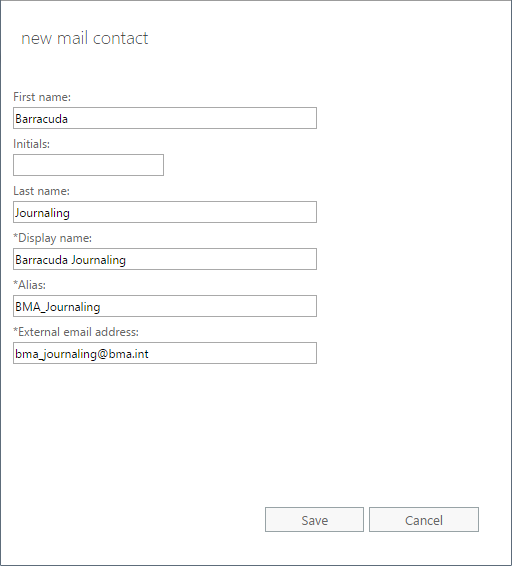
- Click save .
Barracuda Networks recommends hiding the mail contact from the Global Address List. You can use the following PowerShell command to hide the mail contact:
Get-MailContact | Where {$_.Name -eq "Barracuda Journaling"} | Set-MailContact -HiddenFromAddressListsEnabled $True
Enter the following command to verify the setting:
Get-MailContact | Where {$_.Name -eq "Barracuda Journaling"} | Format-table Name, HiddenFromAddressListsEnabled
Step 4. Create a Send Connector for the Remote Domain
To ensure proper mail flow, verify that the Barracuda Message Archiver send connector has a lower cost value than the send connector for outbound SMTP traffic.
To route journaled mail that is sent to the contact to the Barracuda Message Archiver, use the following steps to create a Send Connector for the Remote Domain:
- Log in to the EAC, click mail flow in the left pane, select send connectors at the top of the page, and then click the + symbol to create a new send connector:
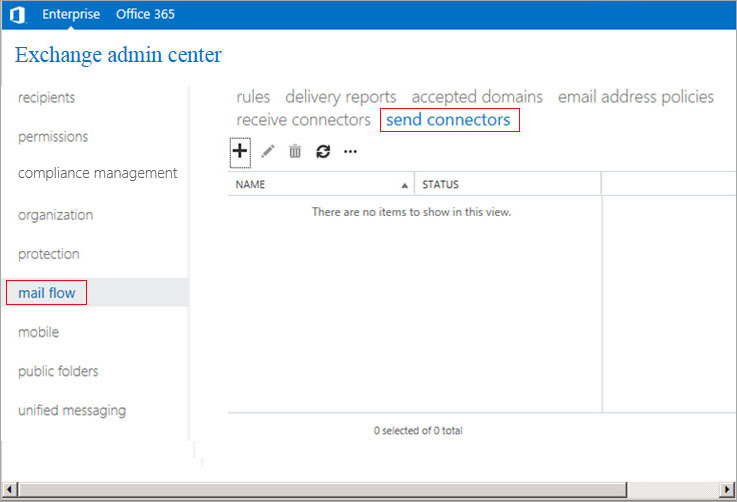
- In the Name field, enter a name for the connector, and in the Type section, select Custom:

- Click next. In the Network settings page, select Route mail through smart hosts:
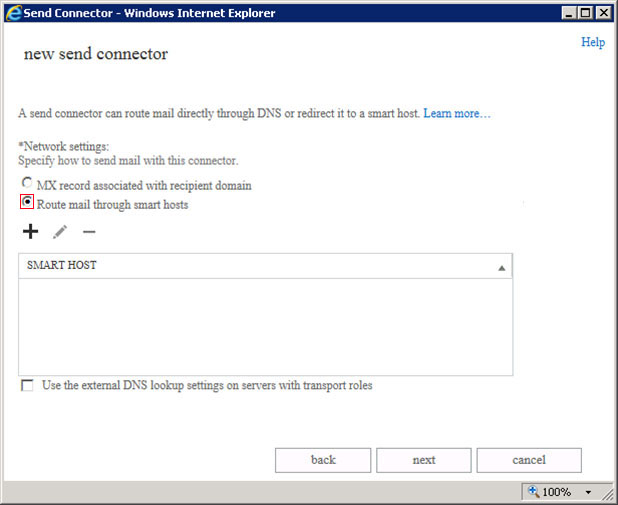
- Click next. In the add smart host page, type the service IP address configured in Step 2. Configure the Barracuda Load Balancer ADC , for example, type: 192.168.1.100
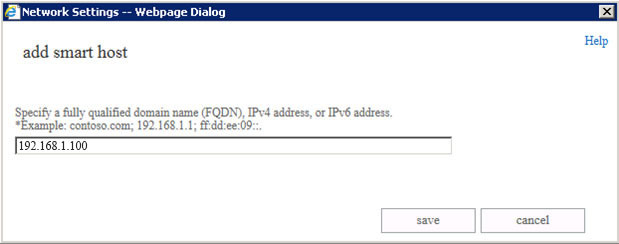
- Click save. The FQDN or IP Address displays in the SMART HOST list; verify the address:
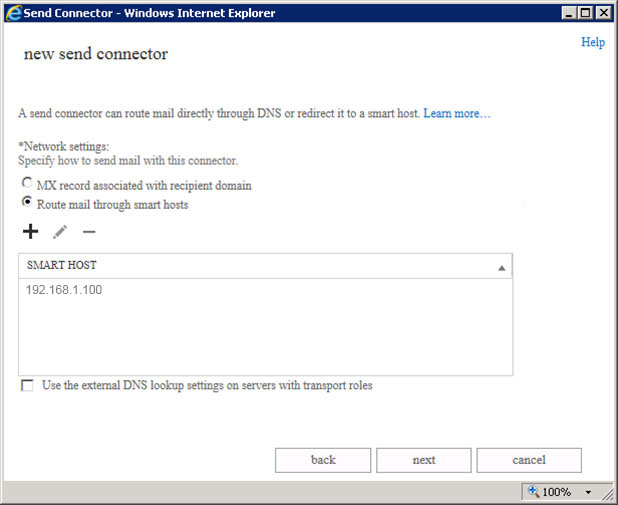
- Click next. In the Smart host authentication page, because authentication is not used on the smart host connection to the Barracuda Message Archiver, no changes are necessary; click next:
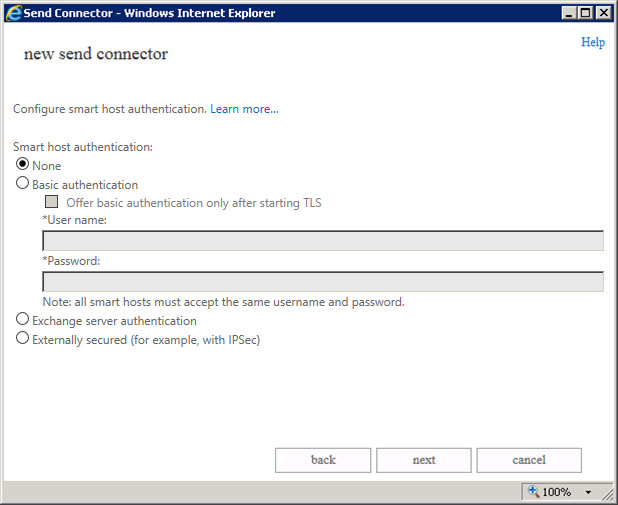
- In the Address space section, click the + symbol:
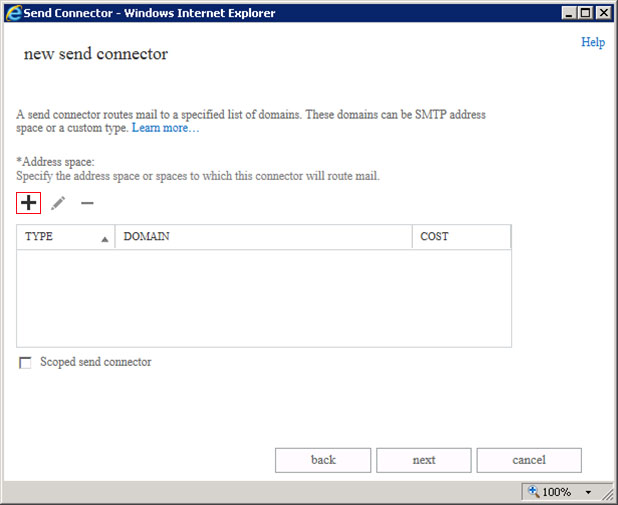
- In the Address Space page, enter the domain that matches the domain for the external email address used to create the journal contact, for example, bma.int (see Step 2. Create a Remote Domain From the Exchange Management PowerShell):

- The domain is added to the Address space list:
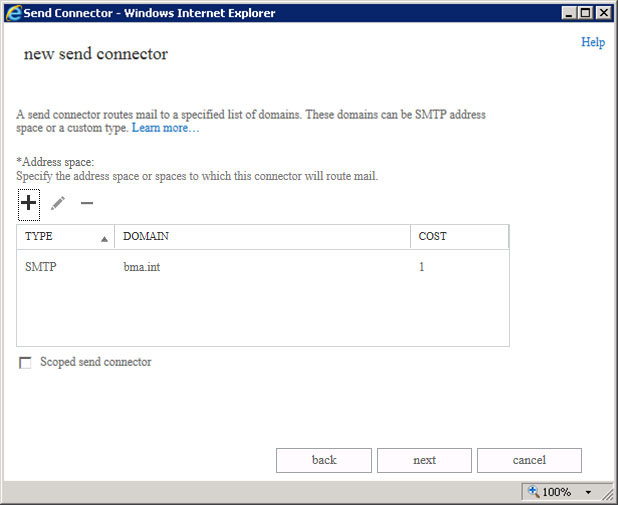
- Click next. In the Source server section, click the + symbol:
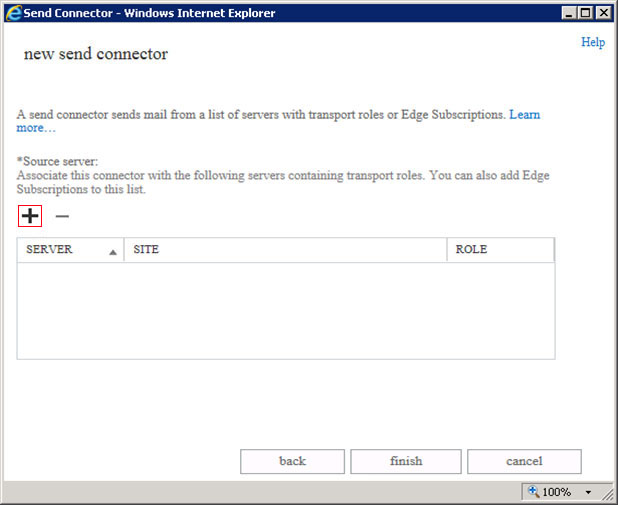
- Verify all of the appropriate Exchange Servers are listed; click add to add additional servers:
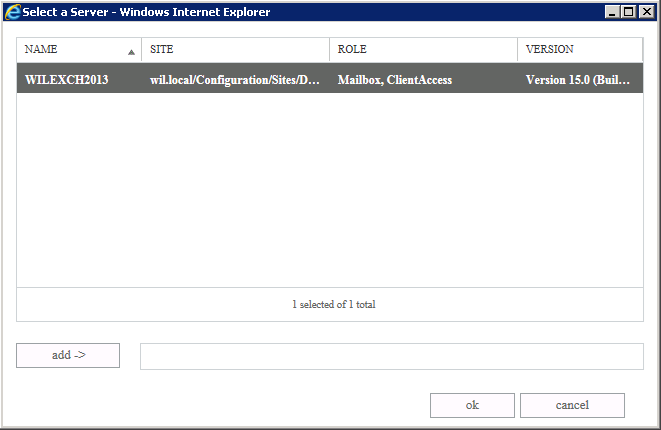
- Click ok. In the Source server page, the selected servers display:
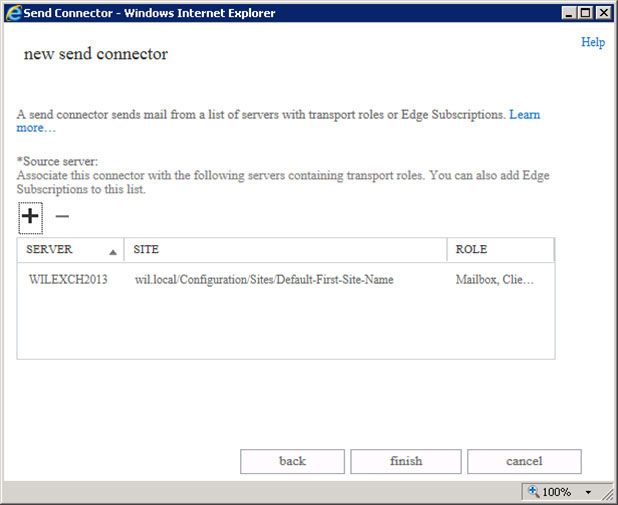
- Click finish. The new send connector displays as enabled in the send connectors list:
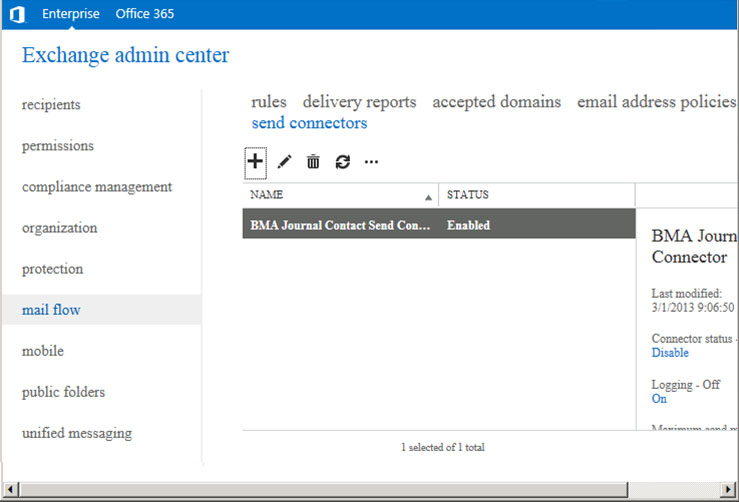
- Click the Edit (
 ) icon to edit the Send Connector properties. From the Maximum send message size (MB) drop-down list, select unlimited, and then click save:
) icon to edit the Send Connector properties. From the Maximum send message size (MB) drop-down list, select unlimited, and then click save:

Step 5. Set Up Mailbox Database Journaling
Use the following steps to set up mailbox database journaling:
You must complete all of the steps in this section for each Exchange Email Database.
- Log into the EAC, click servers in the left pane, select database at the top of the page, and then click the Edit (
 ) icon to edit the database properties:
) icon to edit the database properties: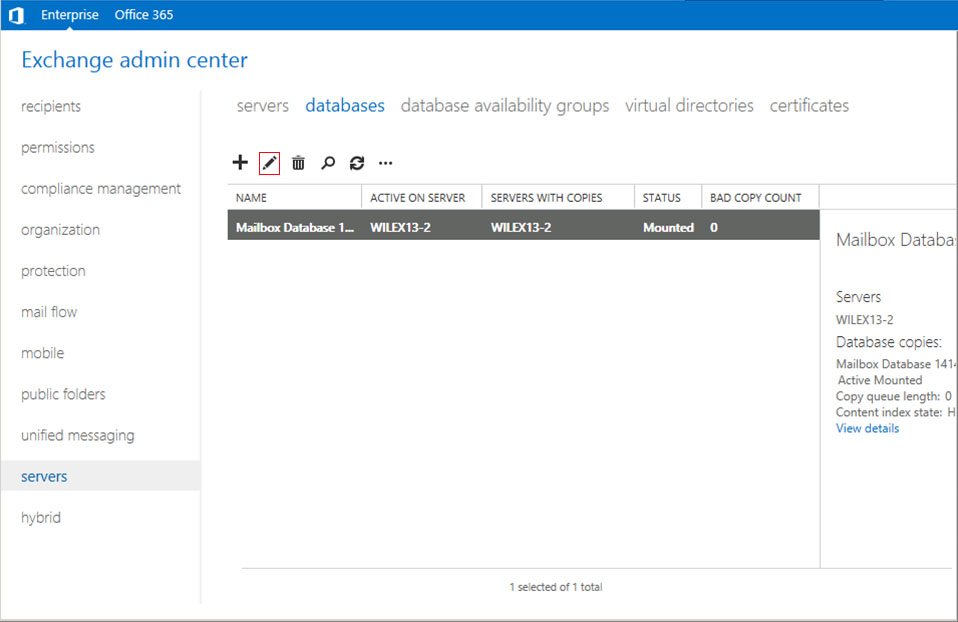
- In the Properties page, click maintenance in the left pane:
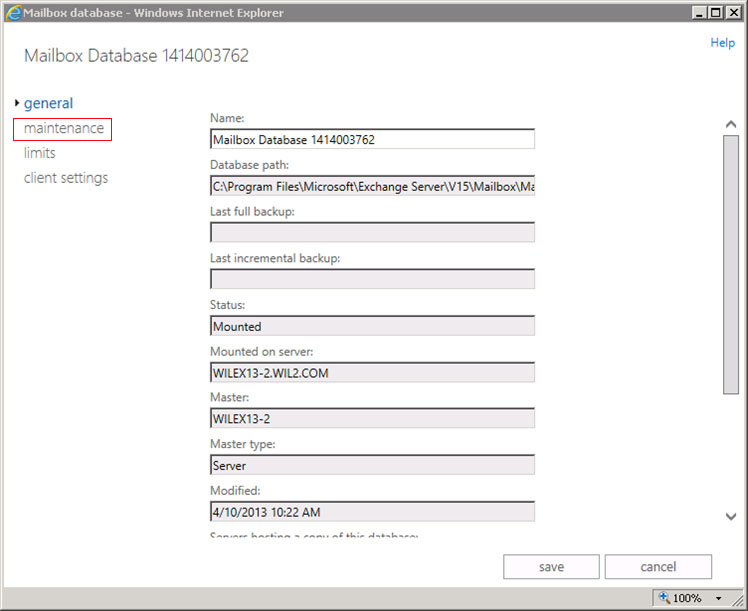
- In the maintenance page, click browse following the Journal recipient field:
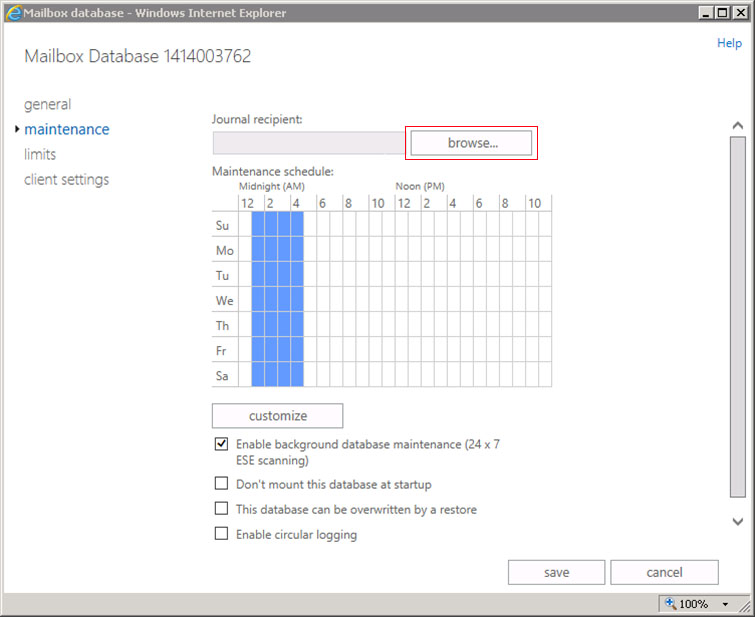
- Navigate to and select the destination location for journaled messages, for example, journal@bma.int:
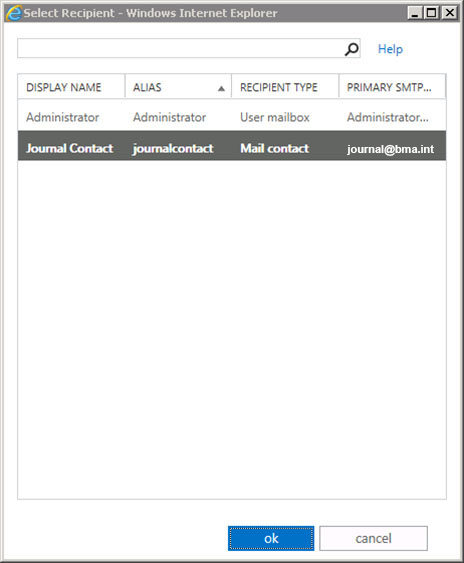
- Click ok to select the journal message recipient. The recipient displays in the maintenance page:
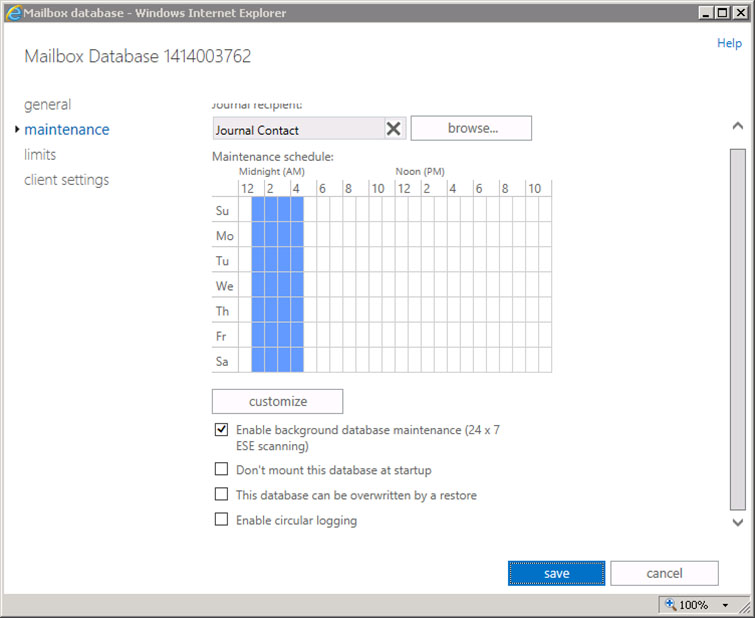
- Click save to save your settings.
The configuration is now complete and journaled mail is forwarded to the Barracuda Message Archiver. Log in to the Barracuda Message Archiver, and go to the BASIC > Search page in the web interface to verify that new mail is being processed. Note that it may take up to 30 minutes before journaled mail is available in the search results.
Barracuda Networks recommends hiding the Journal Contact–as well as any mailbox set up for undeliverable journal reports–from the Global Address List (GAL) so that mail is not sent directly to these accounts.
Configure Envelope Journaling for Microsoft Exchange Server 2013 and Newer - Premium
Microsoft Exchange allows a Journal recipient to be either a mailbox or contact. By using a contact with an email address that is part of a non-existent domain, you can create a send connector that uses SMTP to deliver journaled mail to the Barracuda Message Archiver. Also see Understanding SMTP Forwarding and Trusted Servers.
Excluding Health Monitor Alerts
By default, Health Monitor Alerts are automatically journaled in Exchange 2013. To exclude these alerts from journaling, refer to the Microsoft support article Managed Availability messages are journaled in Exchange Server 2013.
Use the examples included in this article to simplify troubleshooting. Note that you can cut and paste the shell commands directly from this article.
Step 1. Register Each Exchange Server as a Trusted SMTP Server
To ensure that archiving begins as soon as your Exchange Servers are configured to send journal copies, first register each Exchange Server that is in a Client Access Server (CAS) role as a Trusted SMTP Server with the Barracuda Message Archiver on the MAIL SOURCES > SMTP page in the web interface.
- Log into the Barracuda Message Archiver web interface, and go to the MAIL SOURCES > SMTP page.
- In the Trusted SMTP Servers section, enter the details for each Exchange Server that is to journal directly to the Barracuda Message Archiver; click Add after entering the details for each Exchange Server, and then click Save.
Step 2. Create a Remote Domain From the Exchange Management PowerShell
The Remote Domain must not be your normal email domain. The remote domain must be a non-existent and non-routable/unresolvable domain from either inside or outside your organization (such as bma.int). This domain must be used for the email address of the Mail Contact that is to be the journaled message recipient.
In previous versions of Exchange Server, the Exchange Management Console was used to create a Remote Domain; in Exchange Server 2013 the ECP/EAC has no analogous functionality so you must use PowerShell to create the Remote Domain.
To create a Remote Domain, you must enter a Name to describe the domain, and the actual Domain Name to use. In this example, bma.int is the "fake" Domain Name that is used. You can use bma.int or create your own "fake" Domain Name. Note that this Domain Name is used when creating the Mail Contact in Step 4. Create a Send Connector for the Remote Domain.
- Open the Exchange Management Shell.
- Execute the following command to create the remote domain; this command ensures TNEF encoding is disabled and auto-forwarding is enabled:
New-RemoteDomain -DomainName bma.int -Name "Message Archiver Domain"
Get-RemoteDomain | Where {$_.DomainName -eq "bma.int"} | Set-RemoteDomain -TNEFEnabled $false -AutoForwardEnabled $true Enter the following command to verify the settings:
Get-RemoteDomain | Where {$_.DomainName -eq "bma.int"} |Format-table Name, DomainName, TNEFEnabled, AutoForwardEnabledThis command ensures TNEF encoding is disabled and auto-forwarding is enabled. Barracuda Networks recommends disabling TNEF encoding. Auto-forwarding is enabled to allow mail for the contact to be forwarded to the Barracuda Message Archiver.
Step 3. Create a Recipient Mail Contact/Alternate Email Address
The Mail Contact is the account that is to act as a "holding location" for journaled messages. The email address associated with this account is the designated recipient and must be associated with a non-existent, non-routable dummy Domain Name created above in Step 2. Create a Remote Domain From the Exchange Management PowerShell. Use the following steps to create the Mail Contact:
- Log in to the Exchange Admin Center (EAC), and click recipients > contacts.
- Click the + symbol, and click Mail contact:

- In the new mail contact dialog box, enter the following details:
- First name – Type Journal
- Initials – Leave this field blank
- Last name – Type Contact
- Display name – This field populates automatically
- Alias – Type JournalContact
- External email address – Type journal@bma.int
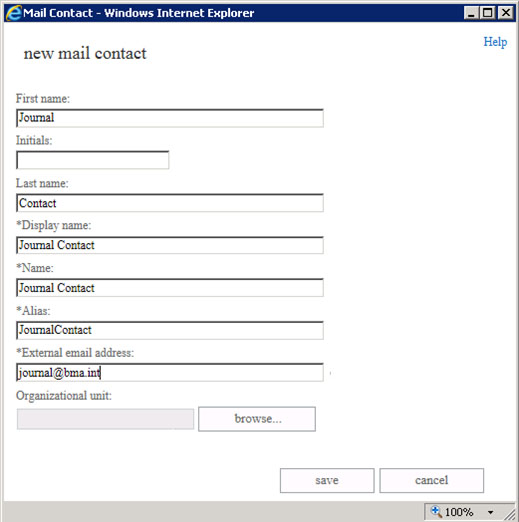
Click save. The new contact displays in the contacts list:
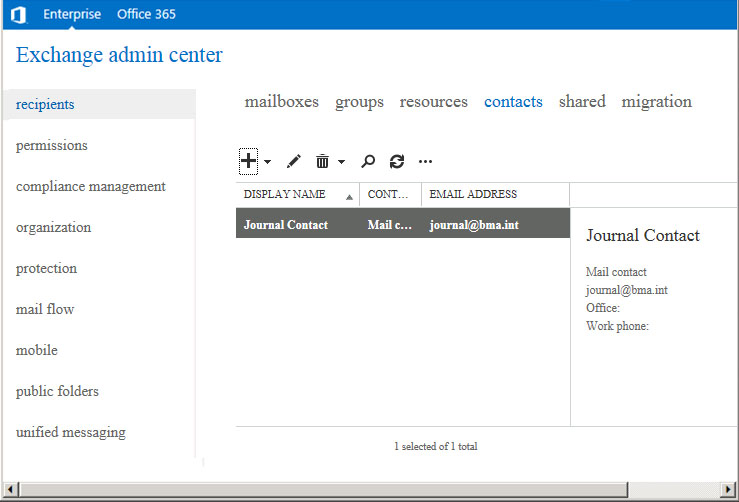
Hide Contact from Global Address List
Barracuda Networks recommends hiding the mail contact from the GAL. One method to hide the mail contact is to utilize the following shell command:Get-MailContact | Where {$_.Name -eq "Journal Contact"} | Set-MailContact -HiddenFromAddressListsEnabled $True
The setting can be verified by executing:
Get-MailContact | Where {$_.Name -eq "Journal Contact"} | Format-table Name, HiddenFromAddressListsEnabled
Alternate Journaling Mailbox
You can configure an additional parameter in Exchange 2013 to specify that a journal report temporarily cannot be delivered. For details, refer to the Journal Reports section of the Microsoft TechNet Journaling article.- In the EAC, click recipients in the left pane, select mailboxes at the top of the page, and click the + symbol to create an alternate journaling mailbox:
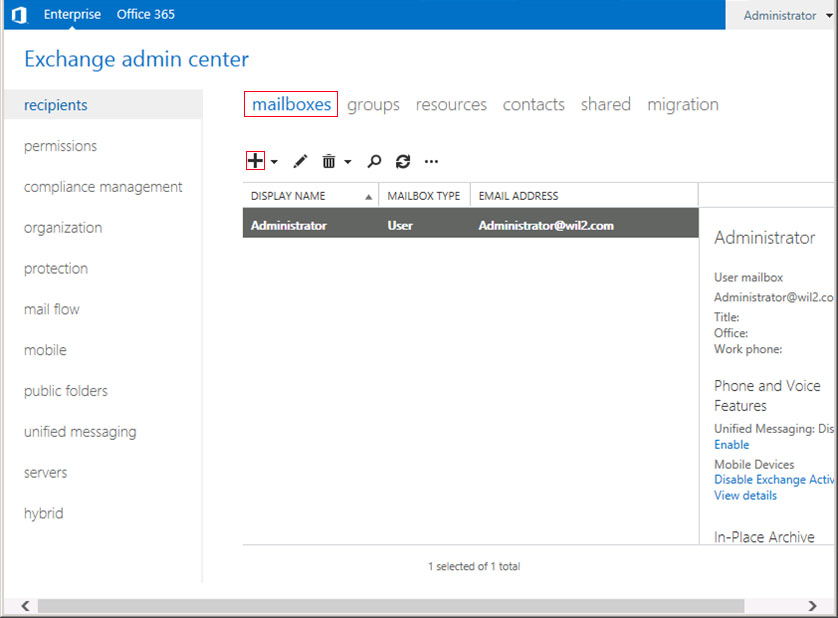
- In the new user mailbox page, enter details for the alternate journaling mailbox:
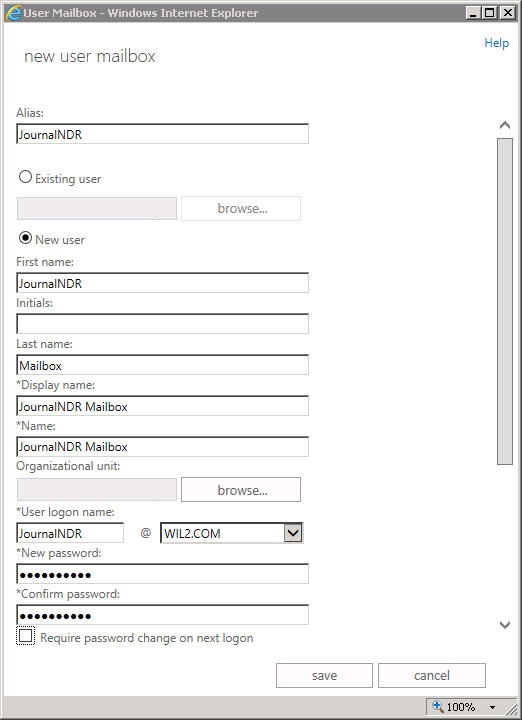
- Click save. The new mailbox displays in the mailboxes list:
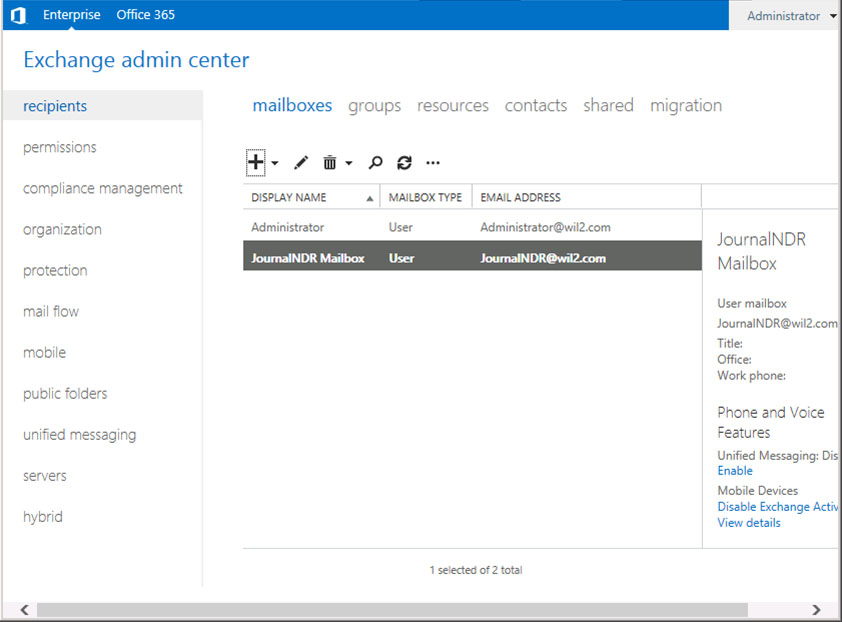
Hide Alternate Contact from Global Address List
Barracuda Networks recommends hiding the alternate mail contact from the GAL; to do so, with the new mailbox still selected, click the Edit ( ![]() ) icon. In the general page, turn on Hide from address lists:
) icon. In the general page, turn on Hide from address lists:
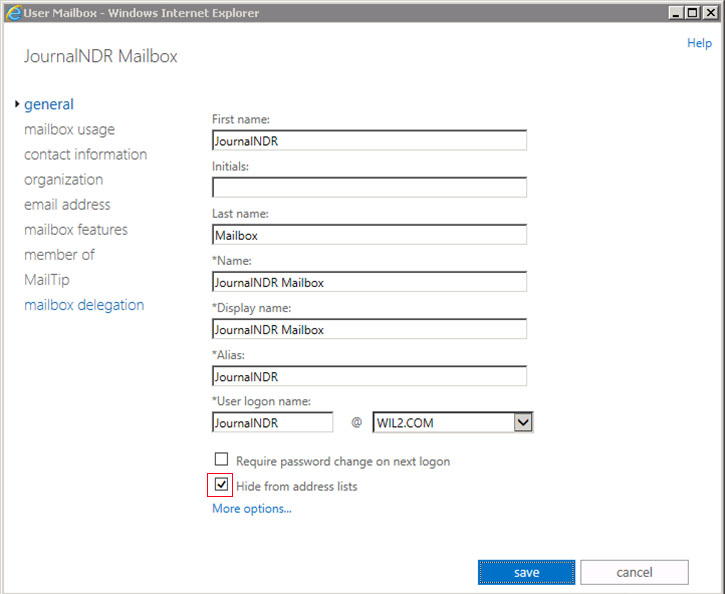
Step 4. Create a Send Connector for the Remote Domain
To route journaled mail that is sent to the contact to the Barracuda Message Archiver, use the following steps to create a Send Connector for the Remote Domain:
- In the EAC click mail flow in the left pane, select send connectors at the top of the page, and then click the + symbol to create a new send connector:

- In the Name field, enter a name for the connector, and in the Type section, select Custom:

- Click next. In the Network settings page, select Route mail through smart hosts:

- Click next. In the add smart host page, type the service IP address configured in Step 2. Configure the Barracuda Load Balancer ADC, for example, type: 192.168.1.100

- Click save. The FQDN or IP address displays in the SMART HOST list; verify the address:

- Click next. In the Smart host authentication page, because authentication is not used on the smart host connection to the Barracuda Message Archiver, no changes are necessary; click next:

- In the Address space section, click the + symbol:

- In the Address Space page, enter the domain that matches the domain for the external email address used to create the journal contact, for example, bma.int (see Step 2. Create a Remote Domain From the Exchange Management PowerShell):

- The domain is added to the Address space list:

- Click next. In the Source server section, click the + symbol:

- Verify all the Exchange Servers that are in the CAS role are listed; click add to add additional servers:

- Click ok. In the Source server page, the selected servers display:

- Click finish. The new send connector displays as enabled in the send connectors list:

- Click the Edit (
 ) icon to edit the Send Connector properties. From the Maximum send message size (MB) drop-down list, select unlimited:
) icon to edit the Send Connector properties. From the Maximum send message size (MB) drop-down list, select unlimited:

- Click save.
Step 5. Create a Journal Rule
Use the following steps to set up a journal rule:
- Log into the Microsoft Purview compliance portal, navigate to Solutions > Data lifecycle management > Exchange (legacy) > Journal rules, and then select + New rule.
- On the Define journal rule settings page, provide a name for the journal rule and then configure the following options:
- Send journal reports to – Type journal@[non-routable domain]. For example, type:
journal@bma.int Journal rule name – Type Barracuda Message Archiver Journal Rule
Journal messages sent or received from – Select Apply to all Messages.
Type of message to journal – Select All Messages.
- Send journal reports to – Type journal@[non-routable domain]. For example, type:
Select Next, review the settings, and then click Submit to create the journal rule.
- To create an NDR recipient, navigate to Solutions > Data lifecycle management > Exchange (legacy).
- Click the Settings icon.
In Send undeliverable journal reports to, enter the email address of a valid user account. Note that the mailbox must be a mail user, mail contact, or external user, not an Exchange Online Mailbox.
Click Save.
The configuration is now complete and journaled mail is forwarded to the Barracuda Message Archiver. Log into the Barracuda Message Archiver, and go to the BASIC > Search page in the web interface to verify that new mail is being processed. Note that it may take up to 30 minutes before journaled mail is available in the search results.
Configure Envelope Journaling for Microsoft Exchange Server 2007 and 2010
Depending on your Client Access Licenses (CALs), you may need to apply these rules at the mail server level rather than the hub transport level. For more information, see the Microsoft TechNet article Overview of Compliance Features.
Step 1. Register Each Exchange Server as a Trusted SMTP Server
To ensure that journaled message archiving begins as soon as your Exchange Servers are configured to send them, register each Exchange Server as a Trusted SMTP Server with the Barracuda Message Archiver (on the MAIL SOURCES > SMTP page) prior to configuring your Exchange Servers. Also see Understanding SMTP Forwarding and Trusted Servers.
Once the Barracuda Message Archiver is configured to receive SMTP traffic, you must complete the following from the Exchange Management Console (EMC) of each Exchange Server that will be journaling directly into the Barracuda Message Archiver:
- From Recipient Configuration – Create a Mail Contact that is to act as the recipient of all journaled messages.
- From Organization Configuration > Hub Transport – Create the following items:
- a (non-routable) Remote Domain, to act as the recipient domain for journaled traffic
- a Send Connector, for routing journaled messages
- a Journaling Rule to actually enable journaling on your Exchange Server
Step 2. Configure the Barracuda Message Archiver
On the Barracuda Message Archiver, use the following steps to enable SMTP forwarding:
- Go to the MAIL SOURCES > SMTP page.
- In the Trusted SMTP Servers section, enter the IP address of each Exchange Server that is to journal directly to the Barracuda Message Archiver.
Step 3. Create a Remote Domain
The Remote Domain must be a non-existent or externally non-routable and unresolvable domain, from either inside or outside your organization, and must match the Mail Contact that is the recipient of journaled messages as it is used by the Exchange Server for routing all SMTP Journal traffic. Use the following steps to create a remote domain:
- Open the EMC, expand Organization Configuration, select Hub Transport, and click the Remote Domains tab in the center pane.
- In the Actions panel in the right pane, click New Remote Domain. The New Remote Domain dialog displays.
- Enter a Name to describe the domain, and the actual Domain name you want to use. In this example, bma.int is the "fake" domain name that is used. You will use this domain name later when creating the Mail Contact:
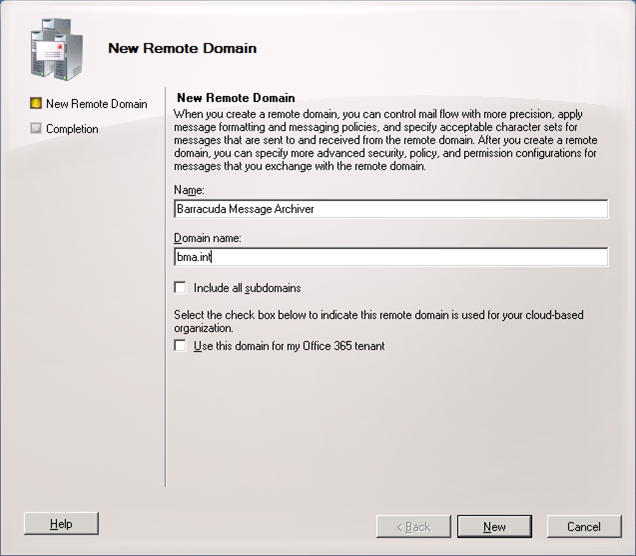
- Click New to verify the domain settings, and click Finish to save your settings. The newly created domain displays in the Remote Domains list.
- Double-click on the newly created domain to open the Properties dialog for the newly created domain, and:
- In Exchange 2007, select Format of original message sent as attachment to the journal report.
- In Exchange 2010, select the Message Format tab in the Properties dialog box.
- Select the following options to ensure journal messages sent to this domain are MIME Plain Text format (rather than the unsupported Exchange Rich Text format):
- In the Message Format Options section, turn on Allow automatic forward.
In the Exchange rich-text format section, select Never Use:
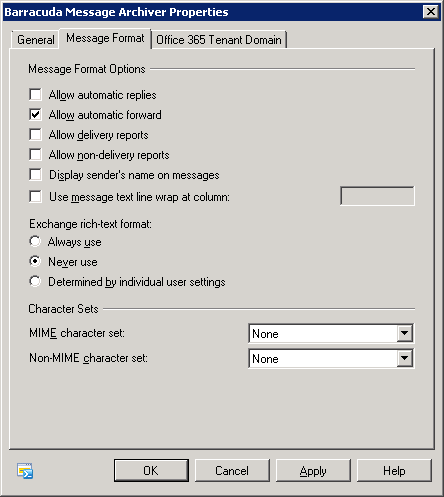
Verify that only Never use and Allow automatic forward are selected in the dialog box.
- Click Apply to save your settings, and click OK to close the Properties dialog.
Step 4. Create a Mail Contact
The Mail Contact is the account that is to act as a "holding location" for journaled messages. The email address associated with this account is the designated recipient, and should be associated with a non-routable "dummy" domain name. Use the following steps to create a Mail Contact:
- In the EMC, expand Recipient Configuration, select Mail Contact, and in the Actions panel, click New Mail Contact:

- In the dialog, select New Contact, and click Next.
- Enter a First name and Last name; the Name field automatically populates based on the entered values. Enter an Alias:

Click Edit to the right of the External e-mail address field, and in the SMTP Address dialog, enter the delivery email address, for example, type: BMA_Journal@bma.int
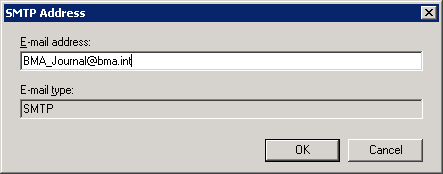
The account name can be anything you want, but the domain name must match what you created in the preceding section, Create a Remote Domain.
- Click OK to close the dialog box. In the Wizard, click Next to verify the information:
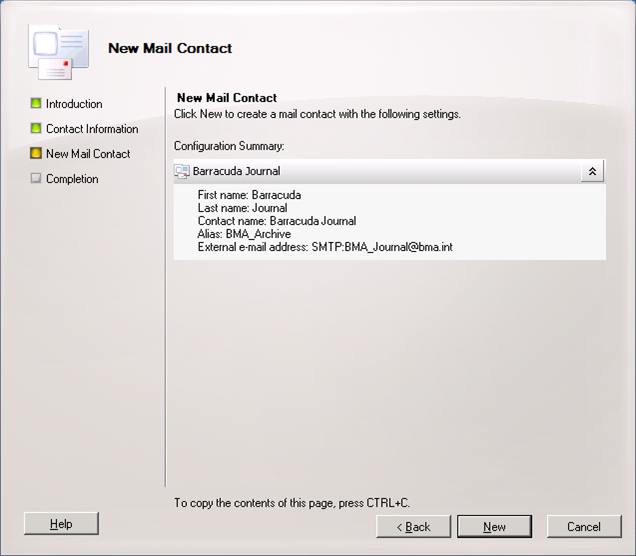
- Click New to create the Mail Contact. The newly-created contact appears in the Mail Contact list. Click Finish to close the Wizard.
Step 5. Create a Send Connector
- In the EMC, expand Organization Configuration, select Hub Transport, and select the Send Connector tab. In the Actions panel, and click New Send Connector. The New Send Connector dialog displays. Enter a Name to identify this send connector, for example, type: Barracuda Message Archiver
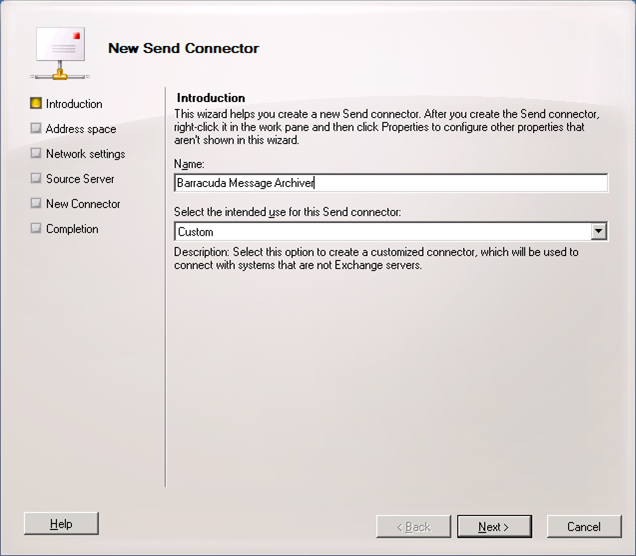
- From the Select the intended use for this Send connector menu, select Custom, and click Next.
- In the Address Space section, click Add; the SMTP Address Space dialog box displays:
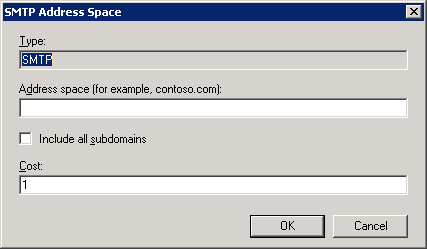
- In the Address space field, enter the domain created earlier, for example, bma.int, and click OK. The SMTP connector is added:
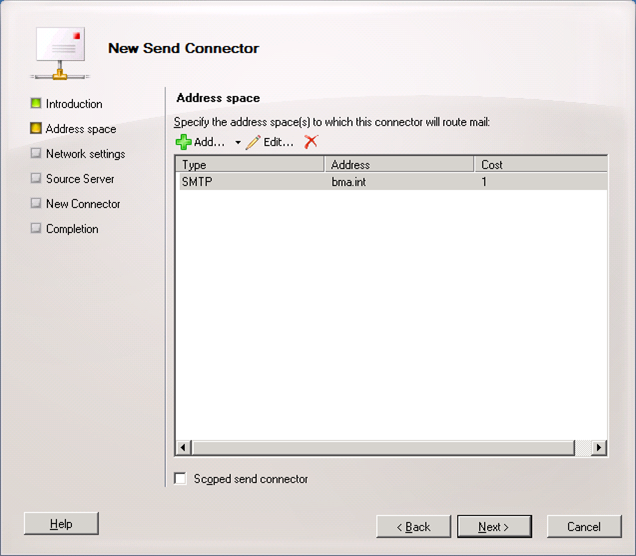
- Click Next. Select Route mail through the following smart host:

- Click Add. In the Add smart host dialog box, select IP address, and type the service IP address configured in Step 2. Configure the Barracuda Load Balancer ADC, for example, type: 192.168.1.100

- Click OK to add the IP address. Click Next, then click Next again.
- In the Source Server page, if your Exchange server is not already listed, click Add to search for and add the server to this list. Click Next to verify your configuration, and click New to create the Send Connector. Click Finish to return to the Send Connectors tab; the newly-created Send Connector displays in the list.
- Right-click on the new Send Connector, and click Properties.
- In the Properties dialog box, clear Maximum message size (KB):
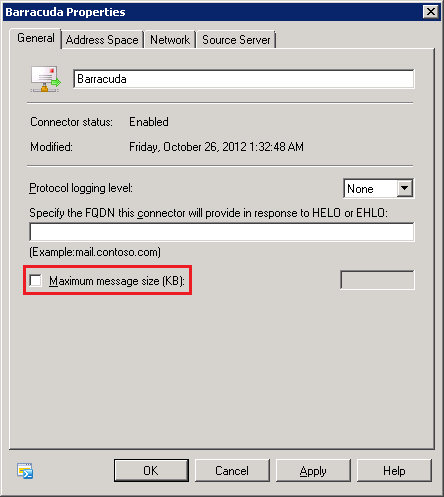
- Click Apply, and then click OK to save your changes and close the dialog box.
Step 6. Create a Journaling Rule
Both the Standard and Enterprise versions of Microsoft Exchange Server 2007 and 2010 support Standard and Premium Journaling. Open the EMC, and complete the following steps to add a journaling rule:
- In the EMC, expand Organization Configuration, select Hub Transport, and select the Journal Rules tab.
- In the Actions panel, click New Journal Rule; the New Journal Rule dialog displays.
- Enter a Rule name, and for the Send Journal reports to e-mail address, click Browse and navigate to and select the mail contact created in the section Create a Mail Contact; for example, BMA_Journal@bma.int

- Select the Scope for archiving; the recommended setting is Global - all messages for the most complete coverage.
- Turn on Enable Rule, click New to create the Journaling rule, and click Finish to return to the Journal Rules tab where the newly-created rule displays in the list.
Your Barracuda Message Archivers are now set up in an Active-Passive configuration for receiving mail from Exchange. If your primary device goes offline, the Barracuda Load Balancer ADC automatically routes the SMTP traffic to the other Barracuda Message Archiver. Once you replace the failed unit, the backup unit sends over any new mail it received to ensure the devices remain in sync.
